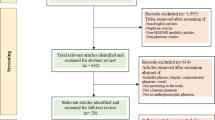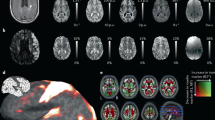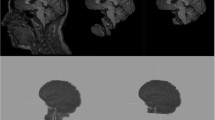Abstract
In this study, we present a magnetic resonance imaging (MRI)-based, high-resolution, numerical model of the head of a healthy human subject. In order to formulate the model, we performed quantitative volumetric segmentation on the human head, using T1-weighted MRI. The high spatial resolution used (1 × 1 × 1 mm3), allowed for the precise computation and visualization of a higher number of anatomical structures than provided by previous models. Furthermore, the high spatial resolution allowed us to study individual thin anatomical structures of clinical relevance not visible by the standard model currently adopted in computational bioelectromagnetics. When we computed the electromagnetic field and specific absorption rate (SAR) at 7 Tesla MRI using this high-resolution model, we were able to obtain a detailed visualization of such fine anatomical structures as the epidermis/dermis, bone structures, bone-marrow, white matter and nasal and eye structures.







Similar content being viewed by others
References
Kainz W et al (2005) Dosimetric comparison of the specific anthropomorphic mannequin (SAM) to 14 anatomical head models using a novel definition for the mobile phone positioning. Phys Med Biol 50(14):3423–3445. doi:10.1088/0031-9155/50/14/016
Gandhi OP, Chen XB (1999) Specific absorption rates and induced current densities for an anatomy-based model of the human for exposure to time-varying magnetic fields of MRI. Magn Reson Med 41(4):816–823. doi :10.1002/(SICI)1522-2594(199904)41:4<816::AID-MRM22>3.0.CO;2-5
Ibrahim TS et al (2005) Electromagnetic perspective on the operation of RF coils at 1.5–11.7 Tesla. Magn Reson Med 54(3):683–690. doi:10.1002/mrm.20596
Collins CM, Smith MB (2001) Calculations of B(1) distribution, SNR, and SAR for a surface coil adjacent to an anatomically-accurate human body model. Magn Reson Med 45(4):692–699. doi:10.1002/mrm.1092
Christ A et al (2006) Characterization of the electromagnetic near-field absorption in layered biological tissue in the frequency range from 30 MHz to 6, 000 MHz. Phys Med Biol 51(19):4951–4965. doi:10.1088/0031-9155/51/19/014
Gabriel C, Gabriel S, Corthout E (1996) The dielectric properties of biological tissues: II. Measurements in the frequency range 10 Hz to 20 GHz. Phys Med Biol 41:2251–2269. doi:10.1088/0031-9155/41/11/002
Ibrahim TS et al (2007) In-depth study of the electromagnetics of ultrahigh-field MRI. NMR Biomed 20(1):58–68. doi:10.1002/nbm.1094
Chou CK et al (1996) Radio frequency electromagnetic exposure: tutorial review on experimental dosimetry. Bioelectromagnetics 17(3):195–208. doi :10.1002/(SICI)1521-186X(1996)17:3<195::AID-BEM5>3.0.CO;2-Z
Nitz WR et al (2005) Specific absorption rate as a poor indicator of magnetic resonance-related implant heating. Invest Radiol 40(12):773–776. doi:10.1097/01.rli.0000185898.59140.91
FDA (2003) Criteria for significant risk investigations of magnetic resonance diagnostic devices. Center for Devices and Radiological Health
IEC (2002) International Standard, medical equipment, part 2–33: particular requirements for the safety of the magnetic resonance equipment for medical diagnosis, 2nd revision. International Electrotechnical Commission 601-2-33, Geneva, p 29–31
Kunz KS, Luebbers RJ (1993) The finite difference time domain method for electromagnetics. CRC Press, Boca Raton, p 448
Taflove A, Hagness SC (2000) Computational electrodynamics: the finite-difference time-domain method. Artech House, Boston
Fischl B et al (2002) Whole brain segmentation: automated labeling of neuroanatomical structures in the human brain. Neuron 33(3):341–355. doi:10.1016/S0896-6273(02)00569-X
Testut L, Jacob O (1974) Trattato di Anatomia Topografica con applicazioni medico-chirurgiche, ed UTET. Turin, Italy
Filipek PA et al (1994) The young adult human brain: an MRI-based morphometric analysis. Cereb Cortex 4(4):344–360. doi:10.1093/cercor/4.4.344
Fawcett D, Jensh R (2002) Bloom and Fawcett’s concise histology, 2nd edn. H. Arnold. London
Gray H, Williams PL (2092) Bannister LH (1995) Gray’s anatomy: the anatomical basis of medicine and surgery, 38th edn. Churchill Livingstone, New York, p 2092
v Vorst AA Rosen, Kotsuka Y (2006) RF/microwave interaction with biological tissues. In: Wiley series in microwave and optical engineering. Wiley, Hoboken, xiii, p 330
Gabriel C, Gabriel S, Corthout E (1996) The dielectric properties of biological tissues: I. Literature survey. Phys Med Biol 41:2231–2249. FCC, http://www.fcc.gov/fcc-bin/dielec.sh
Collins CM, Liu W, Wang J, Gruetter R, Vaughan JT, Ugurbil K, Smith MB (2004) Temperature and SAR calculations for a human head within volume and surface coils at 64 and 300 MHz. J Magn Reson Imaging 19:650–656
DeMarco SC, Lazzi G, Liu W, Weiland JD, Humayun MS (2003) Computed SAR and thermal elevation in a 0.25 mm 2-D model of the human eye and head in response to an implanted retinal stimulator—part I: models and methods. Antennas and propagation. IEEE Trans 51:2274–2285
Li QX, Gandhi OP (2006) Thermal implications of the new relaxed IEEE RF safety standard for head exposures to cellular telephones at 835 and 1,900 MHz. IEEE Trans Microw Theory Tech 54:3146–3154
Gabriel C, Gabriel S, Corthout E (1996) The dielectric properties of biological tissues: I. Literature survey. Phys Med Biol 41:2231–2249. doi:10.1088/0031-9155/41/11/001
Yee KS (1966) Numerical solution of initial boundary value problems involving Maxwell’s equations in isotropic media. IEEE Trans Antenn Propag 14(3):302–307. doi:10.1109/TAP.1966.1138693
Berenger JP (1994) A perfectly macthed layer for the absorption of electromagnetic waves. Comput Phys 114:185–200. doi:10.1006/jcph.1994.1159
Jin J-M (1999) Electromagnetic analysis and design in magnetic resonance imaging. Biomedical engineering series. CRC Press, Boca Raton, xiv, p 282
Collins CM et al (2005) Central brightening due to constructive interference with, without, and despite dielectric resonance. J Magn Reson Imaging 21(2):192–196. doi:10.1002/jmri.20245
Blinkov SM, Glezer IëI (1968) The human brain in figures and tables; a quantitative handbook. Basic Books, New York, xxxii, p 482
Chrzanowska G, Beben A (1973) Weight of the brain and body height in man between the ages of 20 and 89 years. Folia Morphol (Warsz) 32(4):391–406
Debakan A, Sadowsky D (1978) Changes in brain weight during the span of human life: relation of brain weights and body heights and body weights. Ann Neurol 4:345–356. doi:10.1002/ana.410040410
Hwang YI et al (1995) Study on the Korean adult cranial capacity. J Korean Med Sci 10:239–242
Miller A et al (1980) Spectral analysis of arterial bruits (phonoangiography): experimental validation. Circulation 61(3):515–520
Peters M, Jancke L, Zilles K (2000) Comparison of overall brain volume and midsagittal corpus callosum surface area as obtained from NMR scans and direct anatomical measures: a within-subject study on autopsy brains. Neuropsychologia 38(10):1375–1381. doi:10.1016/S0028-3932(00)00048-8
Svennerholm L, Bostrom K, Jungbjer B (1997) Changes in weight and compositions of major membrane components of human brain during the span of adult human life of Swedes. Acta Neuropathol 94(4):345–352. doi:10.1007/s004010050717
Caviness VS Jr et al (1995) Advanced application of magnetic resonance imaging in human brain science. Brain Dev 17(6):399–408. doi:10.1016/0387-7604(95)00090-9
Kennedy DN et al (1998) Gyri of the human neocortex: an MRI-based analysis of volume and variance. Cereb Cortex 8(4):372–384. doi:10.1093/cercor/8.4.372
Makris N et al (1999) MRI-Based topographic parcellation of human cerebral white matter and nuclei II. Rationale and applications with systematics of cerebral connectivity. Neuroimage 9(1):18–45. doi:10.1006/nimg.1998.0384
Kruggel F (2006) MRI-based volumetry of head compartments: normative values of healthy adults. Neuroimage 30(1):1–11. doi:10.1016/j.neuroimage.2005.09.063
Visible_Human_Project (1996) The visible human project. US National Library of Medicine
Aubert-Broche B, Evans AC, Collins L (2006) A new improved version of the realistic digital brain phantom. Neuroimage 32(1):138–145. doi:10.1016/j.neuroimage.2006.03.052
Collins DL et al (1998) Design and construction of a realistic digital brain phantom. IEEE Trans Med Imaging 17:463–468. doi:10.1109/42.712135
Schnitzlein H, Murtagh F (1985) Imaging anatomy of the head and spine: a photographic color Atlas of MRI, CT, gross and microscopic anatomy in axial, coronal and sagital planes. Urban & Schwarzenberg, Munich
Bit-Babik G et al (2005) Simulation of exposure and SAR estimation for adult and child heads exposed to radiofrequency energy from portable communication devices. Radiat Res 163(5):580–590. doi:10.1667/RR3353
Collins CM, Smith MB (2003) Spatial resolution of numerical models of man and calculated specific absorption rate using the FDTD method: a study at 64 MHz in a magnetic resonance imaging coil. J Magn Reson Imaging 18(3):383–388. doi:10.1002/jmri.10359
NCRP (1981) Radiofrequency electromagnetic fields: properties, quantities and units, biophysical interaction, and measurement. National Council Radiation Protection and Measurements, Bethesda
Baker KB et al (2006) Variability in RF-induced heating of a deep brain stimulation implant across MR systems. J Magn Reson Imaging 24(6):1236–1242. doi:10.1002/jmri.20769
Kong JA (1990) Electromagnetic wave theory, 2nd edn. Wiley, New York, xi, p 704
Collins CM et al (2002) Numerical calculations of the static magnetic field in three-dimensional multi-tissue models of the human head. Magn Reson Imaging 20(5):413–424. doi:10.1016/S0730-725X(02)00507-6
Fisel CR et al (1989) A general model for susceptibility-based MR contrast. In: Eighth annual meeting of the society of magnetic resonance in medicine. Amsterdam, The Netherlands
Ibrahim TS et al (2001) Dielectric resonances and B(1) field inhomogeneity in UHFMRI: computational analysis and experimental findings. Magn Reson Imaging 19(2):219–226. doi:10.1016/S0730-725X(01)00300-9
Foster KR et al (1979) Dielectric properties of brain tissue between 0.01 and 10 GHz. Phys Med Biol 24(6):1177–1187. doi:10.1088/0031-9155/24/6/008
Gabriel C (2005) Dielectric properties of biological tissue: variation with age. Bioelectromagnetics Suppl 7:S12–S18
Foster KR, Schwan HP (1989) Dielectric properties of tissues and biological materials: a critical review. Crit Rev Biomed Eng 17(1):25–104
Peyman A et al (2007) Dielectric properties of porcine cerebrospinal tissues at microwave frequencies: in vivo, in vitro and systematic variation with age. Phys Med Biol 52(8):2229–2245. doi:10.1088/0031-9155/52/8/013
Katscher U et al (2006) Electric properties tomography (EPT) via MRI. In: ISMRM Fourteenth Scientific Meeting. Seattle
Hurt W, Ziriax J, Mason P (2000) Variability in EMF permittivity values: implications for SAR calculations. IEEE Trans Biomed Eng 47(3):396–401
Mason P et al (2000) Effects of frequency, permittivity, and voxel size on predicted specific absorption rate values in biological tissue during electromagnetic—field exposure. IEEE Trans Microw Theory 48:2050–2058. doi:10.1109/22.884194
Kang G, Gandhi OP (2004) Effect of dielectric properties on the peak 1 and 10 g SAR fro 802.11 a/b/g Frequencies 2.45 and 5.15 to 5.85 GHz. IEEE Trans Electromagn Compat 46:268–274. doi:10.1109/TEMC.2004.826875
Van den Berg CAT (2006) Radiofrequency fields in hyperthermia and MRI. Exploiting their similarities for mutual benefits. Utrecht
Clatz O et al (2007) Dynamic model of communicating hydrocephalus for surgery simulation. IEEE Trans Biomed Eng 54(4):755–758. doi:10.1109/TBME.2006.890146
Greco WR (2007) New practices in computational modeling. Clin Cancer Res 13(4):1074–1075. doi:10.1158/1078-0432.CCR-06-2811
Ayache N (ed) (2004) Computational models for the human body. In:Ciarlet P (ed) Handbook of numerical analysis. Elsevier, Amsterdam, p 670
Coatrieux JL, Bassingthwaighte JB (eds) (2006) Special issue on the physiome and beyond. Proc IEEE 94:671–678. doi:10.1109/JPROC.2006.871765
Acknowledgments
Preparation of this article was supported in part by grants from: The National Association for Research in Schizophrenia and Depression (NARSAD) and the National Institutes of Health National Center for Complementary and Alternative Medicine NCAM (NM); the Fairway Trust and NIH grants NS34189 & EB005149 (DK); R01 EB002459 and P41 RR014075 (GB), and the MIND institute. The authors would like to thank the many people that kindly contributed to this project with discussions and useful insights, including Franz Schmitt, Franz Hebrank and Andreas Potthast (Siemens Medical Systems), CK Chou and Goga Bit Babik (Motorola Corporate EME), Chris Collins (Penn State), David Kaplan, Sergio Fantini, Peter Wong, and Mark Cronin-Golomb (Tufts University). We would like also to thank the colleagues at the A. Martinos Center, including Martjin Cloos, Graham Wiggins, Mary Foley, and Larry Wald for their help with the MRI images, and Mr. George Papadimitriou and Mr. James Howard and for their contributions to this study.
Author information
Authors and Affiliations
Corresponding author
Additional information
N. Makris and L. Angelone contributed equally to this work.
Rights and permissions
About this article
Cite this article
Makris, N., Angelone, L., Tulloch, S. et al. MRI-based anatomical model of the human head for specific absorption rate mapping. Med Biol Eng Comput 46, 1239–1251 (2008). https://doi.org/10.1007/s11517-008-0414-z
Received:
Accepted:
Published:
Issue Date:
DOI: https://doi.org/10.1007/s11517-008-0414-z




